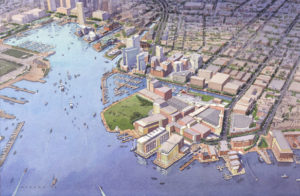A Guest Article for REVITALIZATION by Mark Coleman, Dennis Minano, and David Kirshenbaum.
A robust and functioning infrastructure is the backbone and critical circulatory system that powers our economy, delivers us clean potable drinking water, provides power, facilitates transportation of goods and services, and generally advances our health and prosperity. Without a resilient, reliable and efficient infrastructure, the ability for America to meet the needs of its people, let alone remain competitive in a global economy, is drastically diminished.

Abandoned Packard automobile factory in Detroit. Photo by Storm Cunningham.
Across America there are thousands of run-down and dilapidated sites, bridges, roads and tunnels that are in dire need of repair. Such sites were once part of thriving communities and the efficient delivery of goods and services.
Development of “greenfield” sites has, in recent years, taken precedence over the revitalization of underutilized or diminishing properties, further exacerbating the economic and environmental decline of already distressed properties.
For America to successfully recalibrate and advance its economic future, it must necessitate, within its proposed national and state infrastructure plans, the smart reuse and uplift of underperforming sites while upgrading inefficient infrastructure to renewed and functioning.
Several administrations and congresses (federal) have promised, but not delivered, infrastructure reform or results in the recent past leaving the responsibility to the states and states’ budgets which at the same time have been consistently pressured by rising pension and social program costs/priorities. In 2018, the Administration has proposed its legislative outline for “Rebuilding Infrastructure in America.”
The 53-page framework seeks to have Congress act on a $1.5 trillion infrastructure bill that enables America to transform/upgrade existing and construct new, efficient, resilient and modern infrastructure. This framework extends the traditional focus of infrastructure beyond roads, tunnels, bridges and airports – and focuses on critical systems including drinking and wastewater, energy, public lands, veterans’ hospitals, brownfield and Superfund sites, rural infrastructure and aspects of workforce development.
If the highly partisan political climate in America over the past 12 months is any indication of what to expect in the next 12 months, we are all in store for more entertainment, impasse, intrigue, indecision and ultimately little, or at best a watered down legislative result. Unfortunately, all Americans fall victim to inefficiencies within our political and governance systems. The infrastructure that enables America to thrive is one which focuses political will, resources decision making on the common discourse and universal uplift of the American people and the U.S. economy.
America’s infrastructure is outdated, and in many regions of the country this obsolescence is creating real risks to human health and environment as infrastructure continuously crumbles before our eyes. The Band-Aid approach to pass piecemeal budgets for keeping the lights on, whether it’s in city, county, state or federal government operations, further exacerbates the severe state of need America’s infrastructure poses.
Private markets and industry are critical partners in restoring America’s infrastructure. They require capital and industrial partners including rail, automotive, energy, technology, engineering and other enterprises to support how we can collaboratively finance, design, build, restore and reinvent infrastructure in America.
At stake is the ability for all Americans to have access to basic services as well as the capacity to grow our communities and economy in sustainable ways. Capital markets cannot plan for and don’t respond well to a government which operates inefficiently and erratically. While there are always financial risks to the allocation of capital for public works and infrastructure projects, such risks can be mitigated when leaders work together. Moreover, any strategic direction of capital allocations starts and ends with governmental entities.
What we need is a blueprint for building better partnerships, between governments and the private sector. This blueprint has precedent in many well-conceived and executed examples of partnership success. There are, throughout America and across the globe, examples of public-private partnerships that yield consequential outcomes and impacts for all stakeholders. If, in America, we continue to view our worlds as one comprising a series of competing factions, then our outcomes will remain fractured and the impact/uplift we collectively seek will never be realized.
There is no better example of integrated partnerships than those which have resulted in economic uplift and the restoration of properties once viewed as significant environmental liabilities under federal programs like Superfund. There is no doubt that partnership building is hard work and requires collaboration, effort, flexibility and vision. But there has been a growing body of evidence to show that such partnerships are worth the effort and generate economic, policy and societal benefits.
For example, since 2011, The Nature Conservancy and Dow Chemical Company have collaborated on numerous projects to advance knowledge around the unique role ecosystems play in supporting the resiliency and security of our natural and built environments. Their leading-edge work has advanced the science and economics of ecosystem services, discovering that environmental restoration goes hand-in-hand with economic impact and the ability for natural systems to yield better community and business outcomes.
As of 2016, The Nature Conservancy and Dow have shifted their partnership from research to project deployment and implementation. For example, in their 2016 Summary Report, “Working Together to Value Nature,” the partners state, “across Dow, and at other corporations, there is a regular need to make decision about how to manage real estate, which often incudes natural areas. A standard business decision might be to simply sell land for development; however, natural areas on a site present an opportunity to sell land into conservation, which could generate revenue and maintain ecosystem services.”
The 2016 report also states that by 2025, Dow will deliver $1 billion in value through “projects that are good for business and better for nature.” The Nature Conservancy and Dow have begun transitioning their collaborative research into action. In Freeport, Texas and Tarragona, Spain, they have, for example, verified that nature-based technology and ecosystem services lead to cost-effective water management, reliability and treatment solutions.
In California corporations have worked closely with local municipal, city and state partners and jurisdictional water districts to address water concerns ranging from water clean-up to restrictions and uses that work toward common-sense solutions that mutually impact the region. For example, since 2011 Sacramento-based Aerojet Rocketdyne has worked with regional partners including Golden State Water Company and the Carmichael Water District to divert and deliver up to 4.5 million gallons of water per day to Golden State customers.
The public-private partnership, “American River Pipeline Conveyance Project,” has resulted in a comprehensive and integrated provision of benefits including regional riverbed restoration, strategic water diversion and recovery, enhanced water management and reliability, beneficial reuse of remediated groundwater, and economic savings.

Harbor Point, Baltimore.
Rendering courtesy of EE&K Architects.
In Baltimore, Maryland, stakeholders including the city, developers and Honeywell Corporation have worked together to determine a higher end-use for Harbor Point. Harbor Point is a waterfront property whose historic beginnings and future potential had been saddled by decades of industrial contamination.
But through an integrated effort and unique partnership, the site is on the cusp of a social, economic and environmental resurgence which stands to create more than 7,000 construction jobs and more than 6,000 permanent jobs through a 10-year $1B investment to restore the contaminated property into a bustling mixed-use renaissance that redefines city life in Baltimore.
Of greater consequence, and within a stone’s throw of the Honeywell project is another, more substantial, burgeoning success story—a project known as Tradepoint Atlantic. Once known as “Sparrows Point” and for more than a century featuring among the largest operating steel mills in the nation (and the employer of 30,000+ employees), the mill ultimately suffered a series of debilitating bankruptcies.
A private-public partnership led by Hilco Real Estate and a large Baltimore based private equity co-investor, environmental partners, state, county and city governmental entities as well as federal and state environmental regulators is transforming the 3,100-acre site into a modern tri-modal regional economic engine.
Ultimately, 17,000 or more jobs, $3 billion in economic impact and hundreds of millions of new taxes will be generated as a result of this shared vision and investment. As a result, a fallow reminder of America’s heavy industrial-focused past will become a 21st century modern service, logistics and distribution hub that will greatly enhance the local and regional economy and serve companies, communities and taxing authorities.
Each year, billions of dollars are being reserved and spent (by U.S. corporations) on the cleanup of existing environmental liabilities, as well as the continued operations, maintenance and monitoring (OMM) of remediated and soiled sites.
However, too often former and current regulatory clean-up standards have not provided a framework for public-private partnerships. As a result, corporations remediate contaminated properties under the letter of the outdated and narrowly focused law, but such laws don’t often offer incentives to align a corporation’s assets (remediated properties) with the highest and best public uses for such properties which could, particularly in our current environment, maximize economic potential for communities all across the U.S.
As discussed above, public-private partnership models focused on integrated infrastructure investments have been deployed with notable success. Adopting the best practices from these models in conjunction with a more forward-thinking regulatory regime can yield a national framework by which America can expedite environmental clean-ups in-step with pragmatic solutions for economic recovery, growth, and development – particularly in communities significantly hit by the economic downturn of the past decade.
To be clear, efforts such as those noted above have required the highest degree of trust, coalition-building, and focused teamwork among a variety of constituents with divergent agendas and access to resources. This is not easy work and resources and political will remain in critically short supply.
But in working together, government, civil society and private enterprise can turn former environmental liabilities into local and national assets that restore urban areas, advance local quality of life, and contribute to the goal of economic prosperity for all. As such, environmental transformations can act as both an economic catalyst and a model for other more substantial future successful infrastructure projects across the country.
ABOUT THE AUTHORS:
 Mark C. Coleman is a best-selling and award-winning author and recognized voice on the convergence of sustainability, environmental stewardship, energy, technology, entrepreneurship and innovation.
Mark C. Coleman is a best-selling and award-winning author and recognized voice on the convergence of sustainability, environmental stewardship, energy, technology, entrepreneurship and innovation.
He has advised applied research, academic, government, manufacturing, not-for-profit, and management consulting organizations in the areas of trust-building, sustainability, risk, innovation, operational effectiveness, and business strategy. In 2017 Mr. Coleman was recognized by Trust Across America-Trust Around the World (TAA-TAW) as a Top Thought Leader in Trust. Mr. Coleman holds a Master of Science in Environmental Management and Policy from Rensselaer Polytechnic Institute and two Bachelor of Arts in Environmental Studies and Geography from Binghamton University.
 Dennis R. Minano is a consultant in environmental, energy, governance and transportation infrastructure strategies and serves as a board member, trustee, executive leader and senior advisor to companies, non-profit organizations, economic development organizations and health care institutions.
Dennis R. Minano is a consultant in environmental, energy, governance and transportation infrastructure strategies and serves as a board member, trustee, executive leader and senior advisor to companies, non-profit organizations, economic development organizations and health care institutions.
Mr. Minano is the immediate past Chair of the Board of Sun Corridor Inc., an economic development organization serving Southern Arizona. This follows a career at General Motors, where he served as Vice president of Public Policy, Chief Environmental Officer and Vice President of Communications. Mr. Minano holds a Juris Doctor degree and is a member of various Federal courts, including the U.S. Supreme Court, and was an adjunct Professor of Environmental Law at the University of Detroit Law School.
 David Kirshenbaum is an experienced real estate professional who has a broad and deep background in property development, leasing, brokerage, acquisitions, dispositions, loan restructuring, asset management and general management. He has been actively involved with the analysis and sale of brownfield properties and portfolios of large industrial companies and PE firms in the US and beyond.
David Kirshenbaum is an experienced real estate professional who has a broad and deep background in property development, leasing, brokerage, acquisitions, dispositions, loan restructuring, asset management and general management. He has been actively involved with the analysis and sale of brownfield properties and portfolios of large industrial companies and PE firms in the US and beyond.
In addition, he has overseen large portfolios of retail projects as well as office assets, affordable rental unit developments, high-end condominiums, and numerous ground-up and rehab retail, office and mixed-use projects. In addition, he has been responsible for residential sales, rentals and operations as well as several stand-alone real estate related businesses such as student housing and public storage facilities. Mr. Kirshenbaum graduated Phi Beta Kappa from Emory University, received his JD degree from Northwestern University School of Law, and followed that with an MBA from the Kellogg Graduate School of Management.

